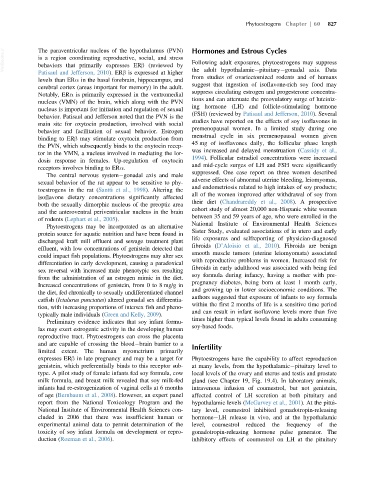Page 869 - Veterinary Toxicology, Basic and Clinical Principles, 3rd Edition
P. 869
Phytoestrogens Chapter | 60 827
VetBooks.ir The paraventricular nucleus of the hypothalamus (PVN) Hormones and Estrous Cycles
is a region coordinating reproductive, social, and stress
Following adult exposures, phytoestrogens may suppress
behaviors that primarily expresses ERβ (reviewed by
Patisaul and Jefferson, 2010). ERβ is expressed at higher the adult hypothalamic pituitary gonadal axis. Data
from studies of ovariectomized rodents and of humans
levels than ERα in the basal forebrain, hippocampus, and
suggest that ingestion of isoflavone-rich soy food may
cerebral cortex (areas important for memory) in the adult.
suppress circulating estrogen and progesterone concentra-
Notably, ERα is primarily expressed in the ventromedial
tions and can attenuate the preovulatory surge of luteiniz-
nucleus (VMN) of the brain, which along with the PVN
ing hormone (LH) and follicle-stimulating hormone
nucleus is important for initiation and regulation of sexual
(FSH) (reviewed by Patisaul and Jefferson, 2010). Several
behavior. Patisaul and Jefferson noted that the PVN is the
studies have reported on the effects of soy isoflavones in
main site for oxytocin production, involved with social
premenopausal women. In a limited study during one
behavior and facilitation of sexual behavior. Estrogen
menstrual cycle in six premenopausal women given
binding to ERβ may stimulate oxytocin production from
45 mg of isoflavones daily, the follicular phase length
the PVN, which subsequently binds to the oxytocin recep-
was increased and delayed menstruation (Cassidy et al.,
tor in the VMN, a nucleus involved in mediating the lor-
1994). Follicular estradiol concentrations were increased
dosis response in females. Up-regulation of oxytocin
and mid-cycle surges of LH and FSH were significantly
receptors involves binding to ERα.
suppressed. One case report on three women described
The central nervous system gonadal axis and male
adverse effects of abnormal uterine bleeding, leiomyomas,
sexual behavior of the rat appear to be sensitive to phy-
and endometriosis related to high intakes of soy products;
toestrogens in the rat (Santti et al., 1998). Altering the
all of the women improved after withdrawal of soy from
isoflavone dietary concentrations significantly affected
their diet (Chandrareddy et al., 2008). A prospective
both the sexually dimorphic nucleus of the preoptic area
cohort study of almost 20,000 non-Hispanic white women
and the anteroventral periventricular nucleus in the brain
between 35 and 59 years of age, who were enrolled in the
of rodents (Lephart et al., 2005).
National Institute of Environmental Health Sciences
Phytoestrogens may be incorporated as an alternative
Sister Study, evaluated associations of in utero and early
protein source for aquatic nutrition and have been found in
life exposures and selfreporting of physician-diagnosed
discharged kraft mill effluent and sewage treatment plant
fibroids (D’Aloisio et al., 2010). Fibroids are benign
effluent, with low concentrations of genistein detected that
smooth muscle tumors (uterine leiomyomata) associated
could impact fish populations. Phytoestrogens may alter sex
with reproductive problems in women. Increased risk for
differentiation in early development, causing a paradoxical
fibroids in early adulthood was associated with being fed
sex reversal with increased male phenotypic sex resulting
soy formula during infancy, having a mother with pre-
from the administration of an estrogen mimic in the diet.
pregnancy diabetes, being born at least 1 month early,
Increased concentrations of genistein, from 0 to 8 mg/g in
and growing up in lower socioeconomic conditions. The
the diet, fed chronically to sexually undifferentiated channel
authors suggested that exposure of infants to soy formula
catfish (Ictalurus punctatus) altered gonadal sex differentia-
within the first 2 months of life is a sensitive time period
tion, with increasing proportions of intersex fish and pheno-
and can result in infant isoflavone levels more than five
typically male individuals (Green and Kelly, 2009).
times higher than typical levels found in adults consuming
Preliminary evidence indicates that soy infant formu-
soy-based foods.
las may exert estrogenic activity in the developing human
reproductive tract. Phytoestrogens can cross the placenta
and are capable of crossing the blood brain barrier to a Infertility
limited extent. The human myometrium primarily
expresses ERβ in late pregnancy and may be a target for Phytoestrogens have the capability to affect reproduction
genistein, which preferentially binds to this receptor sub- at many levels, from the hypothalamic pituitary level to
type. A pilot study of female infants fed soy formula, cow local levels of the ovary and uterus and testis and prostate
milk formula, and breast milk revealed that soy milk-fed gland (see Chapter 19, Fig. 19.4). In laboratory animals,
infants had re-estrogenization of vaginal cells at 6 months intravenous infusion of coumestrol, but not genistein,
of age (Bernbaum et al., 2008). However, an expert panel affected control of LH secretion at both pituitary and
report from the National Toxicology Program and the hypothalamic levels (McGarvey et al., 2001). At the pitui-
National Institute of Environmental Health Sciences con- tary level, coumestrol inhibited gonadotropin-releasing
cluded in 2006 that there was insufficient human or hormone LH release in vivo, and at the hypothalamic
experimental animal data to permit determination of the level, coumestrol reduced the frequency of the
toxicity of soy infant formula on development or repro- gonadotropin-releasing hormone pulse generator. The
duction (Rozman et al., 2006). inhibitory effects of coumestrol on LH at the pituitary

